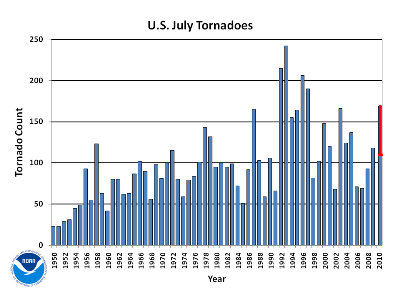Did You Know?
Tornado Count
Final monthly tornado counts are typically less than the preliminary count. This can be due to some phenomena being inaccurately reported as tornadic activity or a single tornado being reported multiple times. Tornado accounts are reported to the local National Weather Service forecast offices who are responsible for going into the field and verifying each tornado reported. This process often takes several months to complete. Once all reports have been investigated, the final count is published by the Storm Prediction Center (SPC).
The Tornado Monthly Climate Reports are written using the preliminary numbers because the final data is not available at the time of production. Historically, for every 100 preliminary tornado reports, at least 65 tornadoes are confirmed. An error bar is depicted on the tornado count graphic representing this uncertainty in the preliminary tornado count.
The following U.S. studies performed by SPC meteorologists offer deeper context and discussion regarding the frequency and distribution of tornado intensity climatologies:
-
Edwards, R., H. E. Brooks, and H. Cohn, 2021: Changes in tornado climatology accompanying the Enhanced
Fujita scale. J. Appl. Meteor. Climatol., 60, 1465-1482
DOI: 10.1175/JAMC-D-21-0058.1. - Mccarthy, Daniel & Schaefer, Joseph. (2004). Tornado trends over the past thirty years. paper presented at 14th Conference on Applied Meteorology.
July 2010 was a fairly active month with 169 preliminary tornado reports across the U.S. and two fatalities directly related to a tornado, according to the Storm Prediction Center (SPC). Unlike the previous several months, there were no massive tornado outbreaks, but at least one tornado was reported on 26 of the 31 days during July. Tornado activity for the month tended to be clustered in the Northern Plains and the Great Lakes, where an active storm pattern brought a series of disturbances to the region for the second month in a row.
Two significant tornadoes during July occurred in regions that do not typically receive tornadoes. The first tornado occurred in Bronx County, New York on July 25th. The EF-1 tornado was 100 yards (91 meters) wide and brought 100 mph (161 km/hr) winds along a path of 0.6 miles (1 km) and was associated with 7 injuries. This was only the second tornado in The Bronx since records began in 1950, and was the first tornado observed since September 1974. The other rare tornado occurred in northeast Montana in Sheridan County on July 26th. The EF-3 tornado had a path width of 0.5 mile (0.8 km) and was on the ground for 18 miles (30 km) and had estimated wind speeds of 150 mph (241 km/hr). There have only been three other F-3 tornadoes in Montana’s history. There were two fatalities and one injury directly related to the Sheridan County tornado - tying as the deadliest tornado in Montana’s history. Two fatalities occurred with an F-1 tornado on June 10, 1923.
The largest tornado outbreak of the month occurred on July 22nd when twenty three tornadoes were reported across the U.S., mainly in southern Wisconsin. The storm system associated with the tornadoes also brought copious amounts of rainfall to the region, please see the Global Hazards page for additional information on the flooding impacts. Weather conditions across the region were favorable for heavy rainfall and severe thunderstorms. The atmosphere was loaded with low-level moisture and a low pressure center in the area provided the required spin for tornado development. The strongest tornado of the outbreak occurred near Big Bend, Wisconsin, 18 miles (29 km) southwest of Milwaukee. The EF-2 tornado had winds of 115–120 mph (185–193 km/hr), was 100 yards (91 meters) wide, and remained on the ground for about 1 mile (1.6 km) . Fortunately, there were no fatalities or injuries reported with this tornado.
 NOAA's National Centers for Environmental Information
NOAA's National Centers for Environmental Information



